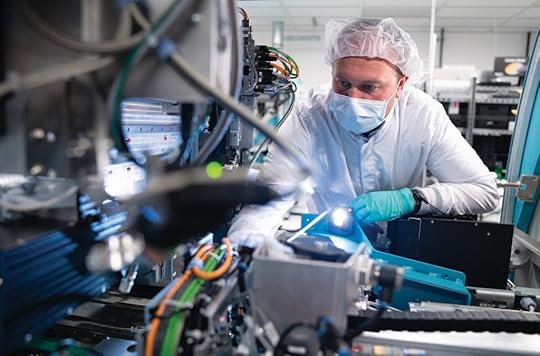Powering the future: Securing America with domestically made microelectronics
Defense technologies that span multifunction sensing, electronic warfare, communications, and radar demand the most advanced microchips to outpace evolving threats and stay ahead of current technology. A focus on smaller size, energy efficiency, tighter packaging, and most importantly – speed – set the tone for success.
For decades, much of the world’s semiconductor production migrated offshore, leaving the US exposed to potential supply chain vulnerabilities and global military threats. Reversing that trend through onshoring is now viewed as essential to rebuild a resilient industrial base capable of sustaining long-term innovation and mission success.
“The most significant trend we’re seeing right now is the push to bring manufacturing microelectronics – also known as semiconductors – back to the U.S. from the Far East,” said Vern Boyle, vice president of Northrop Grumman’s Microelectronics Center. “After decades of outsourcing, there’s a growing recognition of the vulnerabilities that came with relying heavily on overseas production. This realization has ignited a movement to expand semiconductor fabrication within the United States. At Northrop Grumman, we’re proud to lead the charge by continuing to do what we’ve always done — manufacturing semiconductors right here at home.”
Nowhere is that more evident than in the company’s dual-use innovations and its record-breaking Terahertz (THz) chip which showcases how cutting-edge design and manufacturing capabilities can deliver both immediate application benefits and long-term technological advantages. In 2016, the Northrop Grumman THz chip became the first of its kind to reach an unprecedented processing speed of one terahertz, marking a historic milestone in chip technology and computing power.
“The program’s purpose was to create high-speed, high-processing-rate technology that is 1,000 times faster than the nearest competing technology,” said Boyle. “Communications is one application, high-rate sensing of environmental phenomenology for weather prediction is another. We’re in the early stages on the application side and have matured the technology to the point where we’re starting to build systems with it.”
This revolutionary breakthrough earned its place in the Guinness World Records for containing the fastest chip transistors in existence, a record that remains unchallenged to this day.
Blending dual-use commercial and defense
While commercial industry focuses mainly on delivering the “newest” integrated circuits at high volume, the chips needed for defense applications are typically purpose-built to meet defense requirements. Fewer may be needed, but they’re built for higher functionality and to last the lifetime of the system.
Through years of experience, commercial companies have been technically capable of producing certain components. However, their high-volume, profit-driven business models are often misaligned with the specialized, low-quantity needs of defense applications. Defense products are tailored for exceptional multifunction sensing, electronic warfare, communications, and radar for fighter planes. It’s microelectronics that allow those comms and radar systems to function across a variety of frequency bands that aren’t accessible otherwise, while remaining protected in high threat contested environments.
“Radar applications are a prime example of the multifunction systems we design these custom parts for,” explained Boyle. “For years, Northrop Grumman has been building radars for platforms like the F-16, F-22, and F-35. These systems require components capable of generating extremely high transmit power while covering wide frequency ranges, enabling them to detect and track threats at long distances. The advanced chips inside enable this high-level radar performance, ultimately enhancing the survivability of the platforms they’re integrated into.”
 Recently, Northrop Grumman proactively took steps to strengthen the infrastructure for making secure, military-grade chips by opening the Microelectronics Center to external aerospace and defense companies. (Photo courtesy of Northrop Grumman)
Recently, Northrop Grumman proactively took steps to strengthen the infrastructure for making secure, military-grade chips by opening the Microelectronics Center to external aerospace and defense companies. (Photo courtesy of Northrop Grumman)Not just chips but ‘packages’ of them
As the demand for more powerful and versatile electronics grows – especially in defense and other cutting-edge industries – advanced packaging is becoming essential to overcoming the limits of traditional semiconductor manufacturing, paving the way for smarter, more capable systems.
Advanced packaging involves integrating multiple chips into compact, high-performance packages, essentially stacking or combining semiconductors designed for different tasks into a single, cohesive unit. This approach enables significantly more functionality within a smaller footprint, improving speed, efficiency, and overall system performance. It is becoming essential to overcoming the limits of traditional semiconductor manufacturing, paving the way for smarter, more capable systems.
“In some cases, it’s about improving performance, by choosing the best combination of chips for the package or improving the connection between a transceiver and a digital processor,” explained Boyle. “In others, it’s about maximizing space, like in the front-end of an F-35 or any tactical fighter, where space is at a premium and fitting more functionality into a smaller footprint is critical. Ultimately, advanced packaging delivers a powerful combination of enhanced performance, smaller size, and greater energy efficiency, making it a transformative technology for modern applications.”
Delivering and innovating for today and tomorrow
Recently, Northrop Grumman proactively took steps to strengthen the infrastructure for making secure, military-grade chips by opening the Microelectronics Center to external aerospace and defense companies. This now allows a multitude of platform providers to leverage Northrop Grumman expertise and access the company’s three US government-accredited semiconductor manufacturing facilities. Boyle noted how this decision expands the secure production of defense microelectronics on US soil.
“By opening our defense-grade manufacturing facilities to partners, Northrop Grumman is expanding and strengthening the resilience of America’s semiconductor industry and supply chain. We are providing partners with unprecedented access to design and develop domestic chips, as well as the ability to directly purchase from us, enhancing collaboration across the broader defense industrial base.”
The same defense companies who compete on myriad programs are the ones leading the charge to make the nation safer, and they need mission-tailored, resilient and secure microelectronics to do it. Northrop Grumman can not only provide those services but has an intimate knowledge of defense applications across every domain. Now the work that has been done for commercial partners can be elevated and specified to benefit defense customers.
Through the open access business model, these companies now have access to disruptive semiconductor solutions and onshore advanced packaging, proving that American made systems will be powered today and tomorrow by American-made chips.
Douglas A. Macgregor's Blog
- Douglas A. Macgregor's profile
- 28 followers



